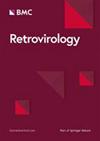HIV-1 潜伏期和反弹的细胞生物学
IF 3.9
3区 医学
Q3 VIROLOGY
引用次数: 0
摘要
具有转录潜伏形式的复制能力前病毒主要存在于一小部分记忆 CD4+ T 细胞中,是治愈 HIV-1 感染的主要障碍,因为它们是抗逆转录病毒疗法中断后几乎不可避免的病毒反弹的源头。在过去 30 年中,利用转化细胞系(如 Jurkat T 细胞模型)进行的研究发现了启动 HIV-1 转录所必需的许多因素。然而,正如本综述所强调的那样,仍有几种不甚明了的机制有待阐明,包括转录复合体启动子近端暂停的分子基础以及从 7SK snRNP 传递 P-TEFb 的详细机制。此外,HIV-1 转录的核心悖论仍未解决:在没有 Tat 的情况下,最初几轮转录是如何实现的?转化细胞模型的一个关键局限是它们不能再现活跃效应细胞和静止记忆 T 细胞之间的转变。因此,在适当的生理背景下研究 HIV-1 潜伏期逆转和 LRA 效力的分子机制需要利用原始细胞模型。最近利用从供体和病毒潜伏期体外细胞模型中回收的潜伏感染细胞进行的 HIV-1 转录机理研究表明,记忆 CD4+ T 细胞中 HIV-1 转录的主要障碍是前病毒启动子的限制性表观遗传特征、NFAT 和 NF-κB 等关键转录启动因子的细胞质封存以及细胞转录延伸因子 P-TEFb 的低表达。消除残余病毒库的最重要方案之一是故意重新激活潜伏的 HIV-1 病毒,以清除持续潜伏的感染细胞--"冲击和杀灭 "策略。要使 "冲击和杀灭 "有效,必须发现有效、无毒的潜伏逆转剂(LRA)。由于病毒在原代细胞中的再活化受到多重限制,因此了解刺激 P-TEFb 生物发生、启动因子活化和逆转前病毒表观遗传限制所必需的 T 细胞信号机制已成为开发更有效 LRA 的先决条件。本文章由计算机程序翻译,如有差异,请以英文原文为准。
The cell biology of HIV-1 latency and rebound
Transcriptionally latent forms of replication-competent proviruses, present primarily in a small subset of memory CD4+ T cells, pose the primary barrier to a cure for HIV-1 infection because they are the source of the viral rebound that almost inevitably follows the interruption of antiretroviral therapy. Over the last 30 years, many of the factors essential for initiating HIV-1 transcription have been identified in studies performed using transformed cell lines, such as the Jurkat T-cell model. However, as highlighted in this review, several poorly understood mechanisms still need to be elucidated, including the molecular basis for promoter-proximal pausing of the transcribing complex and the detailed mechanism of the delivery of P-TEFb from 7SK snRNP. Furthermore, the central paradox of HIV-1 transcription remains unsolved: how are the initial rounds of transcription achieved in the absence of Tat? A critical limitation of the transformed cell models is that they do not recapitulate the transitions between active effector cells and quiescent memory T cells. Therefore, investigation of the molecular mechanisms of HIV-1 latency reversal and LRA efficacy in a proper physiological context requires the utilization of primary cell models. Recent mechanistic studies of HIV-1 transcription using latently infected cells recovered from donors and ex vivo cellular models of viral latency have demonstrated that the primary blocks to HIV-1 transcription in memory CD4+ T cells are restrictive epigenetic features at the proviral promoter, the cytoplasmic sequestration of key transcription initiation factors such as NFAT and NF-κB, and the vanishingly low expression of the cellular transcription elongation factor P-TEFb. One of the foremost schemes to eliminate the residual reservoir is to deliberately reactivate latent HIV-1 proviruses to enable clearance of persisting latently infected cells—the “Shock and Kill” strategy. For “Shock and Kill” to become efficient, effective, non-toxic latency-reversing agents (LRAs) must be discovered. Since multiple restrictions limit viral reactivation in primary cells, understanding the T-cell signaling mechanisms that are essential for stimulating P-TEFb biogenesis, initiation factor activation, and reversing the proviral epigenetic restrictions have become a prerequisite for the development of more effective LRAs.
求助全文
通过发布文献求助,成功后即可免费获取论文全文。
去求助
来源期刊

Retrovirology
医学-病毒学
CiteScore
5.80
自引率
3.00%
发文量
24
审稿时长
>0 weeks
期刊介绍:
Retrovirology is an open access, online journal that publishes stringently peer-reviewed, high-impact articles on host-pathogen interactions, fundamental mechanisms of replication, immune defenses, animal models, and clinical science relating to retroviruses. Retroviruses are pleiotropically found in animals. Well-described examples include avian, murine and primate retroviruses.
Two human retroviruses are especially important pathogens. These are the human immunodeficiency virus, HIV, and the human T-cell leukemia virus, HTLV. HIV causes AIDS while HTLV-1 is the etiological agent for adult T-cell leukemia and HTLV-1-associated myelopathy/tropical spastic paraparesis. Retrovirology aims to cover comprehensively all aspects of human and animal retrovirus research.
 求助内容:
求助内容: 应助结果提醒方式:
应助结果提醒方式:


